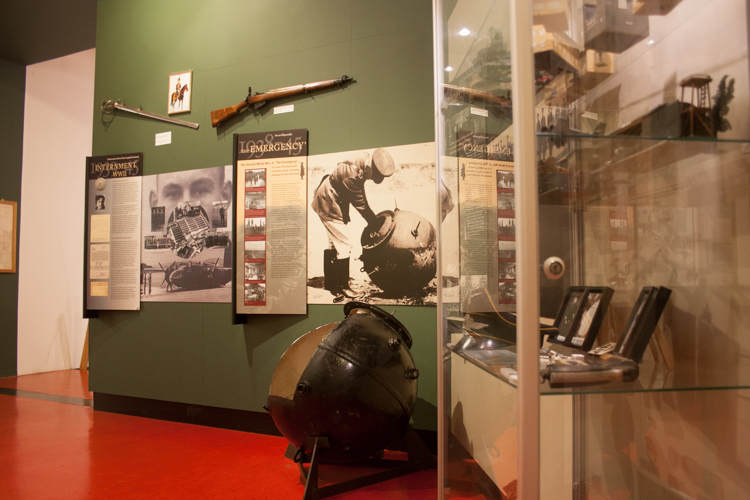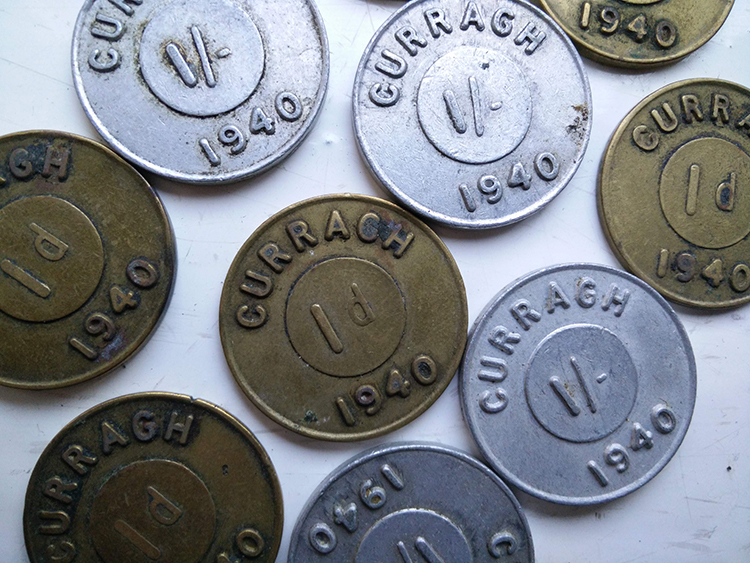|
|
| (13 dazwischenliegende Versionen von einem anderen Benutzer werden nicht angezeigt) |
| Zeile 1: |
Zeile 1: |
| | + | [[Datei:IRELAND_curragh-camp_1.jpg|750px|thumb|left|Aerial View of the Curragh Camp, Co. Kildare. Image Courtesy of the National Library of Ireland]] |
| | | | |
| − | [[Datei:IRELAND_rudolf-heltzel_1.jpg|750px|thumb|left|Image Courtesy of Rudolf Heltzel Studios]]
| + | In Ireland, the Second World War was euphemistically called “The Emergency”; the country was neutral, prisoners of war were “guests of the state”, and they were interned in very comfortable camp: the Curragh. |
| | | | |
| − | Der in Berlin geborene Rudolf Heltzel war 50 Jahre lang eine zentrale Figur im irischen Kunsthandwerk und Design. Sein aus Gold, Silber und Edelsteinen gefertigter, prachtvoller Schmuck hat seiner Werkstatt in Kilkenny einen internationalen Ruf verschafft.
| + | [[Datei:IRELAND_curragh-camp_2.jpg|750px|thumb|left|The Curragh Military Museum. Image © Ben Adamson]] |
| | | | |
| − | [[Datei:IRELAND_rudolf-heltzel_2.jpg|750px|thumb|left|Image Courtesy of Rudolf Heltzel Studios]]
| + | When the Second World War broke out, Éamon de Valera, then taoiseach (prime minister) and later president of Ireland, reaffirmed the country’s neutrality. Irish ports and airspace were off limits to Axis and Allied forces. The government built No. 2 Internment Camp, also known as K-Lines Camp, on the east side of the Curragh army base in County Kildare, west of Dublin. Any Axis or Allied soldiers who landed in Ireland were interned there. Some of them were bomber pilots who mistook Ireland for Britain; some had to make emergency landings; and some were German aircraft or U-boat crews who landed in Ireland to escape the horrors of war. Around 2,000 Irish Republican Army members were also interned during the war, in No. 1 Internment Camp on the west side of the Curragh base. |
| − | Heltzel war ein Kriegskind: er wurde 1941 in Berlin geboren. Seinen Vater, einen Kirchenkünstler, verschlug es als Kriegsgefangenen in die Sowjetunion. Rudolf wurde mit seiner Mutter und seinem Bruder von Berlin nach Polen evakuiert, wo sie blieben, bis 1946 sämtliche Deutschen des Landes verwiesen wurden. Heltzel machte in Berlin eine Lehre zum Goldschmiedemeister und arbeitete anschließend drei Jahre lang bei dem berühmten Schmuckdesigner Sigurd Persso in Schweden. Im Alter von 25 Jahren erhielt er ein unerwartetes Angebot von der irischen Handelskammer, die darum bemüht war, die Qualität des irischen Designs zu verbessern. Die Hauptinitiative der Kammer, der Kilkenny Design Workshop, war nicht von Erfolg gekrönt. Heltzel arbeitet zwei Jahre lang im KDW und half ihn als Zentrum des modernen irischen Designs aufzubauen, bevor er sein eigenes Studio in Kilkenny gründete, das er bis 2010 führte und dann an seinen Sohn Christoph übergab. Heltzels Schmuckanhänger und Ringe sind auffallend geometrisch und orientieren sich an den Kunstrichtungen des Art Nouveau und des Bauhauses sowie an mittelalterlichen Techniken. Ihre lebhaften Farben greifen jedoch auch auf die Kirchenkunst seines Vaters zurück und auf den Reichtum der frühen christlichen Metallarbeiten und Illustrationen Irlands. Nach 50 Jahren scheinen seine lebendigen künstlerischen Verschmelzungen tief in seinem Ursprungsland und seiner Wahlheimat verwurzelt.
| |
| | | | |
| − | Fintan O’Toole
| + | K-Lines was divided into two compounds separated by a fence topped with barbed wire. The 200 or so Germans were in G camp; the 40 British and Allied internees in B camp. Security was very tight to begin with, but procedures were gradually relaxed after a visit by German ambassador Eduard Hempel in 1940. Later, prisoners on both sides were allowed leave the camp if they gave their word, in writing, to return by an agreed time and not to take part in any activity connected with the war. Initially, parole was for three hours in the afternoons, but this was gradually extended to include two nights a week so that they could go to the races at the nearby Curragh racecourse, or to one of the three cinemas in the area. The prisoners were given a weekly allowance, which was billed to their respective governments. Some of them met local Irish women when they were on parole, married and settled in Ireland. |
| | | | |
| − | [[Datei:IRELAND_rudolf-heltzel_3.jpg|750px|thumb|left|Image Courtesy of Rudolf Heltzel Studios]]{{#newBox:}}
| + | Towards the end of 1943 most of the Allied prisoners were secretly released, and 20 German prisoners were allowed move to Dublin to enrol at university. The Curragh Camp now serves as a training centre for the Irish Defence Forces. The camp’s story during the Second World War was dramatised in the 1998 film The Brylcreem Boys, with Gabriel Byrne as camp commander. |
| | | | |
| − | {{#Galerie:Weitere Bilder|[[Datei:IRELAND_rudolf-heltzel_4.jpg|Image Courtesy of Rudolf Heltzel Studios]],[[Datei:IRELAND_rudolf-heltzel_5.jpg|Image Courtesy of Rudolf Heltzel Studios]],[[Datei:IRELAND_rudolf-heltzel_6.jpg|Image Courtesy of Rudolf Heltzel Studios]],[[Datei:IRELAND_rudolf-heltzel_7.jpg|Image Courtesy of Rudolf Heltzel Studios]]}}{{#newBox:listbox}}
| + | Ralf Sotschek |
| − | ==Standortinformationen== | + | |
| | + | [[Datei:IRELAND_curragh-camp_3.jpg|750px|thumb|left|K-Lines, Curragh Camp. Image Courtesy of the National Library of Ireland]]{{#newBox:}} |
| | + | |
| | + | {{#Galerie:More Images|[[Datei:IRELAND_curragh-camp_4.jpg|Interior of The Curragh Military Museum. Image © Ben Adamson.]],[[Datei:IRELAND_curragh-camp_5.jpg|Tokens used as currency at the Curragh Camp. Image © Ben Adamson.]]}}{{#newBox:listbox}} |
| | + | |
| | + | ==Links== |
| | + | <br> |
| | + | http://www.military.ie/en/info-centre/defence-forces-museums/the-curragh-museum/<br> |
| | + | http://www.imdb.com/title/tt0115770<br> |
| | <br> | | <br> |
| − | '''Addresse'''<br>
| + | |
| − | Rudolf Heltzel Studios<br>
| + | ==Visitor Information== |
| − | 10 Patrick St<br>
| |
| − | Kilkenny<br>
| |
| − | IRELAND - IR<br>
| |
| | <br> | | <br> |
| − | '''Öffnungszeiten'''<br> | + | '''Address'''<br> |
| − | Montag - Samstag 9:30 - 13:00, 14:00 - 17:30 (Schlossen 13:00-14:00 für Mittagessen)
| + | Curragh Camp<br> |
| | + | The Curragh<br> |
| | + | Co. Kildare<br> |
| | + | IRELAND - IR |
| | + | |
| | + | |
| | + | '''Opening Times'''<br> |
| | + | Monday - Wednesday 10:00-12:30 und 14:00-16:30<br> |
| | + | Thursday 14:00-20:00<br> |
| | + | Sunday 14:00-17:00<br> |
| | + | ''Closed Friday, Saturday and Bank Holidays'' <br> |
| | + | |
| | {{#newBox:listbox}} | | {{#newBox:listbox}} |
Aktuelle Version vom 19. Mai 2016, 11:53 Uhr
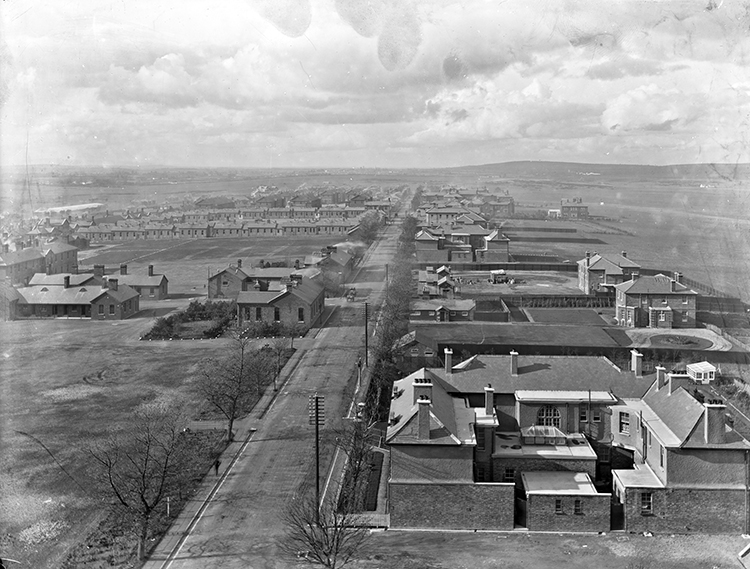
Aerial View of the Curragh Camp, Co. Kildare. Image Courtesy of the National Library of Ireland
In Ireland, the Second World War was euphemistically called “The Emergency”; the country was neutral, prisoners of war were “guests of the state”, and they were interned in very comfortable camp: the Curragh.
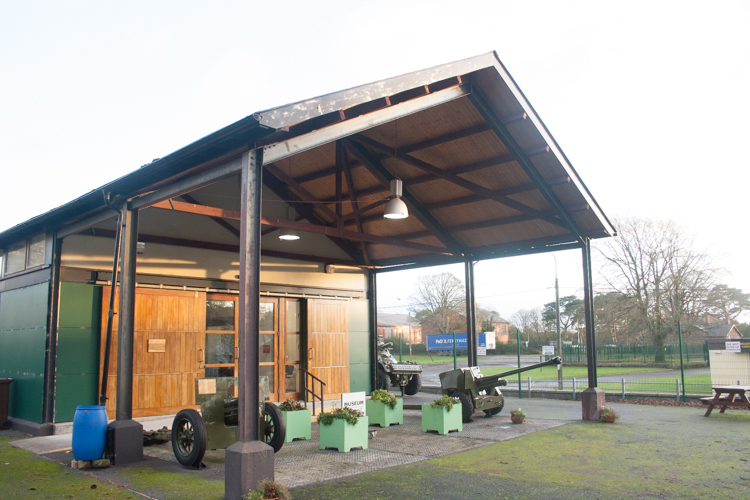
The Curragh Military Museum. Image © Ben Adamson
When the Second World War broke out, Éamon de Valera, then taoiseach (prime minister) and later president of Ireland, reaffirmed the country’s neutrality. Irish ports and airspace were off limits to Axis and Allied forces. The government built No. 2 Internment Camp, also known as K-Lines Camp, on the east side of the Curragh army base in County Kildare, west of Dublin. Any Axis or Allied soldiers who landed in Ireland were interned there. Some of them were bomber pilots who mistook Ireland for Britain; some had to make emergency landings; and some were German aircraft or U-boat crews who landed in Ireland to escape the horrors of war. Around 2,000 Irish Republican Army members were also interned during the war, in No. 1 Internment Camp on the west side of the Curragh base.
K-Lines was divided into two compounds separated by a fence topped with barbed wire. The 200 or so Germans were in G camp; the 40 British and Allied internees in B camp. Security was very tight to begin with, but procedures were gradually relaxed after a visit by German ambassador Eduard Hempel in 1940. Later, prisoners on both sides were allowed leave the camp if they gave their word, in writing, to return by an agreed time and not to take part in any activity connected with the war. Initially, parole was for three hours in the afternoons, but this was gradually extended to include two nights a week so that they could go to the races at the nearby Curragh racecourse, or to one of the three cinemas in the area. The prisoners were given a weekly allowance, which was billed to their respective governments. Some of them met local Irish women when they were on parole, married and settled in Ireland.
Towards the end of 1943 most of the Allied prisoners were secretly released, and 20 German prisoners were allowed move to Dublin to enrol at university. The Curragh Camp now serves as a training centre for the Irish Defence Forces. The camp’s story during the Second World War was dramatised in the 1998 film The Brylcreem Boys, with Gabriel Byrne as camp commander.
Ralf Sotschek
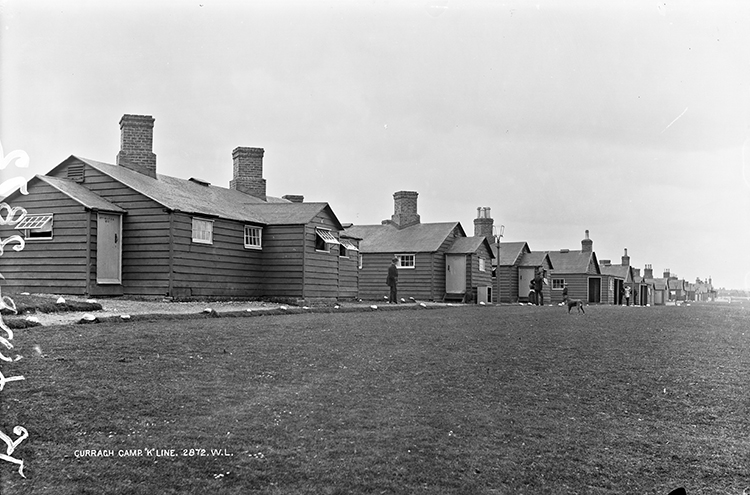
K-Lines, Curragh Camp. Image Courtesy of the National Library of Ireland




